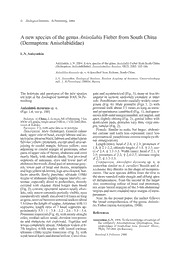
A new species of the genus Anisolabis Fieber from South China (Dermaptera: Anisolabididae) PDF
Preview A new species of the genus Anisolabis Fieber from South China (Dermaptera: Anisolabididae)
© Zoological Institute, St.Petersburg, 2004 A new species of the genus Anisolabis Fieber from South China (Dermaptera: Anisolabididae) L.N. Anisyutkin Anisyutkin, L.N. 2004. A new species of the genus Anisolabis Fieber from South China (Dermaptera: Anisolabididae). Zoosystematica Rossica, 12(2), 2003: 185-186. Anisolabis decorata sp. n. is described from Sichuan, South China. L.N. Anisyutkin, Zoological Institute, Russian Academy of Sciences, Universitetskaya nab. 1, St.Petersburg 199034, Russia. The holotype and paratypes of the new species gate and asymmetrical (Fig. 5), more or less tri- are kept at the Zoological Institute RAS, St.Pe- angular in section; uniformly crenulate at inner tersburg. side. Penultimate sternite caudally widely emar- ginate (Fig. 6). Male genitalia (Figs 1, 2) with Anisolabis decorata sp. n. proximal stalk about 3.5 times as long as meta- (Figs 1-6, see p. 186) and proparameres combined (Fig. 1); metapara- meres with outer margin rounded, not angled, and Holotype. M, China, S. Sichuan, NE of Mianning, 3 km apex slightly oblong (Fig. 2); genital lobes with NNW of Lajiajia, height about 2500 m, 1.VIII.2002 (Bel- denticulate pads, denticles very thin; virga sim- ousov & Kabak). ple, tubular (Fig. 2). Paratypes. 2 F, with same data as in holotype. Female. Similar to male, but larger; abdomi- Description. Male (holotype). General colour nal carinae and keels less expressed; cerci less dark; upper side of head, except labrum and an- asymmetrical; penultimate sternite simple (with- teclypeus, piceous black; labrum and anteclypeus out emargination). fulvous yellow; pronotum, except small area ad- Length (mm): head M 2.4, F 2.8; pronotum M joining to caudal margin, fulvous yellow; area 1.8, F 2.1-2.2; ultimate tergite M 1.8, F 2.5; cer- adjoining to caudal margin of pronotum, other ci M 2.4, F 3.1-3.2. Width (mm): head M 2.1, F parts of upper side of thorax, abdomen and cerci 2.5; pronotum M 2.3, F 2.6-2.7; ultimate tergite nearly black, with reddish shade; four proximal M 2.7, F 3.3-3.5. segments of antennae, eyes and lower part of Comparison. Anisolabis decorata sp. n. is abdomen brownish; distal part of antennae grey- somewhat similar to A. cavalieri Borelli and A. ish; lower part of head and thorax, mouthparts sechuana Bey-Bienko in the shape of metapara- and legs yellowish brown; legs unicoloured. Sur- meres. The new species differs from the first in faces smooth, finely punctate; ultimate (10th) the more rounded outer margin and oblong apex tergite of abdomen slightly rugose laterally; an- of metaparamere, from the second in the larger tennae, especially distal to pedicellum, densely size, contrasting colour of head and pronotum, covered with chaetae. Head longer than broad not acute lateral margins of the 5-8th abdominal (Fig. 3), convex; epicranial sutures nearly obso- tergites and more rounded outer margin of meta- lete, only sutura coronalis partially visible; eyes paramere. comparatively small; eye about 0.6 times as long Note. In the present paper, the author follows as gena; interval between antennal sockets about the broad comprehension of the genus Anisola- 1.6 times the length of scapus. Antennae with 13 bis Fieber (sensu Anisyutkin, 1998). segments; length ratio of 7 basal segments ap- proximately 5.5 : 1 : 3.4 : 2.2 : 2.6 : 3.3 : 3.4. References Pronotum trapezoid (Fig. 4), with nearly straight sides; median sulcus weak; division into prozo- Anisyutkin, L.N. 1998. To the knowledge of earwigs of na and metazona not expressed. Tegmina and the subfamily Anisolabidinae (Dermaptera, Ani- wings completely absent. Abdomen widest at 6- solabididae) of South-East Asia. Entomol. Obozr., 7th tergites; 6-8th tergites with lateral carinae; 77(4): 787-804. (In Russian). ultimate (10th) tergite transverse (Fig. 5), with Received 4 February 2004 weak lateral keels and dorsal hollow. Cerci elon- 186 L.N. Anisyutkin: A new species of Anisolabis (cid:127) ZOOSYST. ROSSICA Vol. 12 1 3 4 5 2 6 Figs 1-6. Anisolabis decorata sp. n., male (holotype). 1, meta- and proparamere and proximal stalk of the male genita- lia from above, schematically; 2, male genitalia from above, proximal stalk not shown, left genital lobes in everted position; 3, head from above; 4, pronotum from above; 5, abdominal apex from above; 6, caudal margin of penultimate sternite from below. Dotted area shows sclerotized parts.
